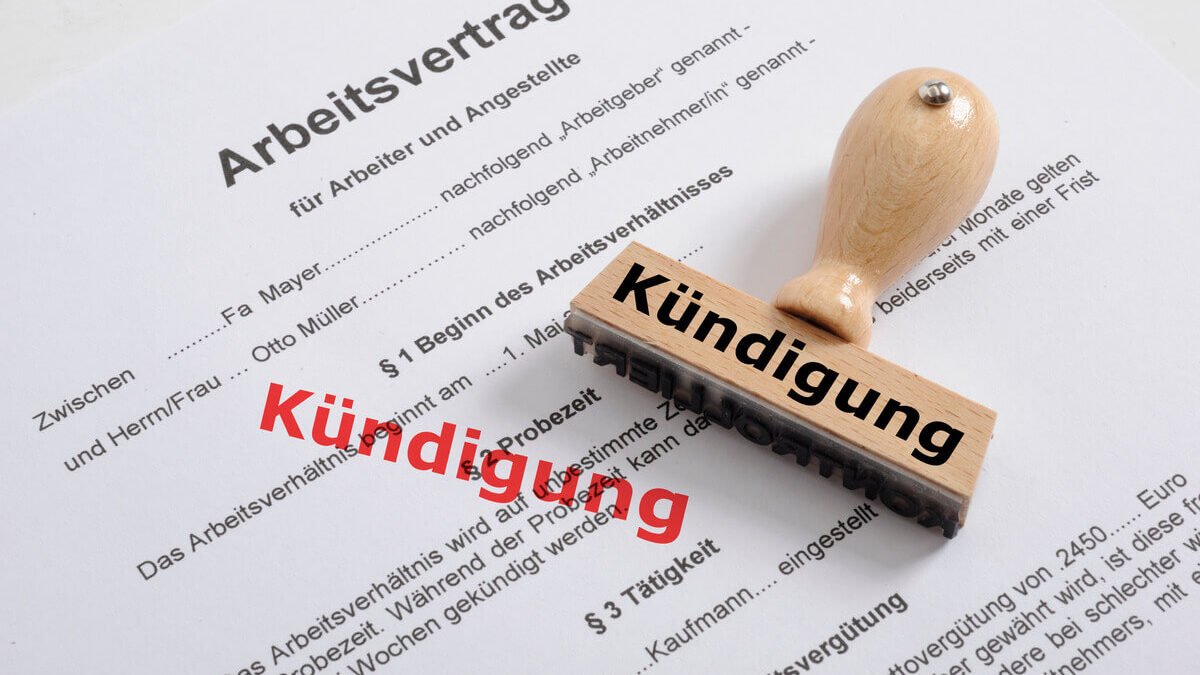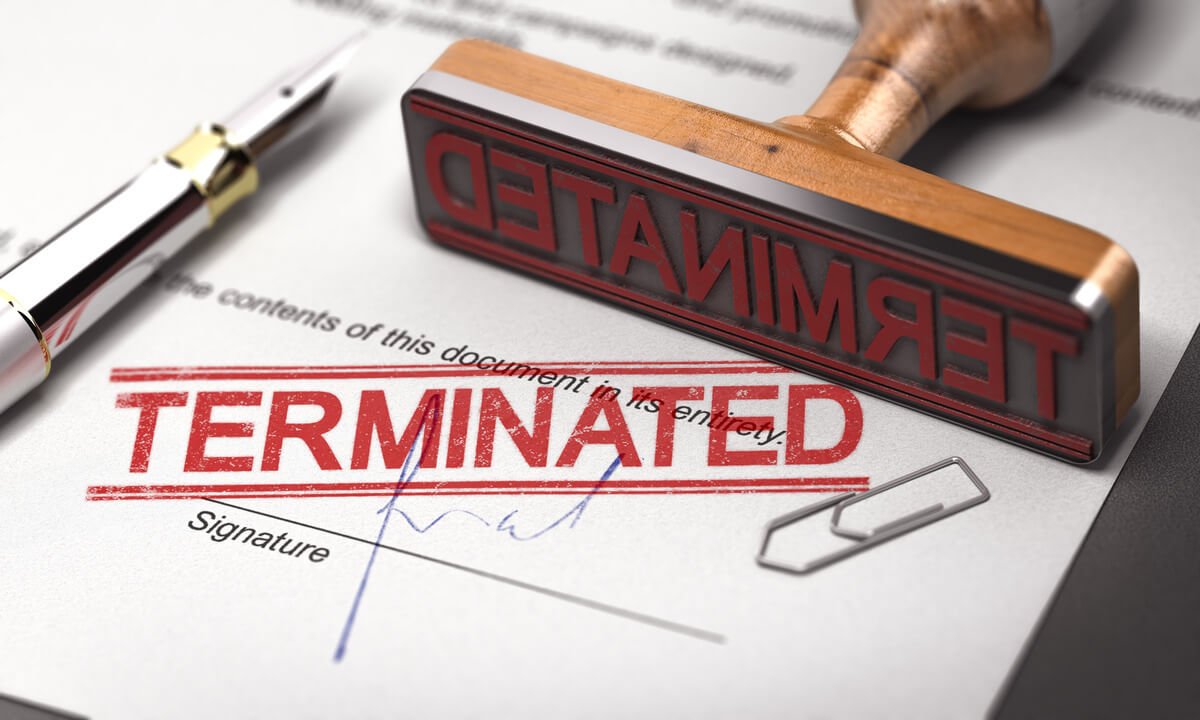

Receiving the termination of the employment contract is rarely a pleasant surprise and can throw many people off balance. is rarely a pleasant surprise and can throw many people off balance. Nevertheless, in the event of termination, it is important to remain calm, avoid serious mistakes and take the necessary legal steps. For example, check the termination letter, register as unemployed and consider taking legal action against the termination. And under no circumstances should you sign anything without careful consideration. In our article, we describe the most important steps you should take after receiving a termination.
Unfairly dismissed in Germany?
Check your severance pay now – you have only 3 weeks to preserve your severance package!
Contents
1. Review the termination letter
Imagine you have received an invitation to an unexpected meeting. When you arrive at the meeting room, you find not only your supervisor but also someone from human resources, both with serious expressions on their faces. They hand you a termination letter with a more or less appropriate explanation. They may even include a severance offer that they would like you to sign.
Now it’s time to stay cool. You should first accept the termination of your employment contract without comment. Even if your blood pressure is rising, you should remain calm, refuse to sign anything – and above all, do not rashly sign an extremely disadvantageous termination agreement. After receiving the termination, you should check the termination letter at home and in peace for the following points:
Do you need help with German labor law?
Get a free initial consultation now – with an expert on German labor law!
Check receipt of the termination letter
The termination letter must have been received in the proper manner. The employer can deliver the termination letter in person or through a representative. In the example above, receipt in front of witnesses is relatively clear. However, the termination can also be sent by post. And that is where it gets more complicated. The typical ways of delivering a termination letter by post are as follows:
1. Delivery by regular letter
If the termination letter is sent by regular post, it becomes problematic if the employee claims never to have received it. In this case, the employer must prove that the letter was actually delivered, which is practically impossible. For this reason, terminations are rarely delivered by regular letter. In the event of termination by regular letter, this should be discussed with your lawyer.
2. Delivery by registered letter with return receipt
The employee must confirm receipt of the letter in writing. If this is not done, the letter will be returned as undeliverable! The employee can therefore refuse to accept the letter or simply not collect it. If acceptance is refused or the letter is not collected until after the deadline has expired, the sender is responsible for the delay in receipt of the declaration.
3. Registered letter with delivery confirmation
The delivery service places the letter directly in the recipient’s letterbox. According to previous case law, delivery was deemed to have taken place as soon as the letter was posted. However, several recent decisions have been handed down, some of which expressly reject this case law and refuse to accept prima facie evidence of delivery in the case of delivery by registered letter. In the event of termination by registered letter, this should be discussed with your solicitor.
4. Delivery by messenger or courier
Another option is delivery by a messenger or courier, who documents the delivery with a confirmation of receipt. This is relatively safe for the employer.
Unfairly dismissed in Germany?
Check your severance pay now – you have only 3 weeks to preserve your severance package!
Observe the three-week period for bringing an action
The receipt of the termination is important for calculating the notice period and the three-week period for bringing an action. A termination is deemed to have been received
- as soon as the recipient can obtain knowledge of the termination under normal circumstances.
- as soon as the termination has been placed in the letterbox. Not only when the letter of termination is actually read.
- even if delivery takes place during holidays.
- in the case of registered mail, if the postman leaves a message that registered mail is available for collection and the employee does not collect it within the specified period.
- even in the event of refusal to accept the letter of termination. Receipt is then legally assumed.
Written form of termination
Termination of an employment contract is only effective with a letter of termination. This means that the employer must ‘sign by hand’ the termination. Termination can only be made in writing, i.e. on paper. Therefore, a termination that is given verbally, sent by email or via text message is not effective. A signature stamp or ‘Docusign signature’ is also not sufficient.
Check responsibilities with regard to authorisation
When the termination of the employment contract is not issued directly by the employer but by an authorised representative, employees should always check whether a power of attorney has been submitted along with the termination letter. In the absence of such authorisation, the employee is entitled to reject the termination on these grounds. A timely rejection — usually within one week — renders the termination ineffective under Section 174 of the German Civil Code (BGB). However, there is no right of rejection if employees are generally aware that the person giving notice has the authority to do so, such as a human resources manager. Even if the employer has previously informed the employee of the authorisation, the employee cannot reject the termination. In such a case, the rejection does not therefore render the termination invalid.
Letter of termination – special protection against dismissal
If special protection against dismissal exists, such as in the case of maternity leave, parental leave or severe disability, the employer must obtain the consent of the competent authority before giving notice of termination. If it has done so, this should also be stated in the letter of termination. The employer must be aware of the pregnancy or severe disability. If they are not aware of this at the time of termination, the employee must inform them within two weeks in the case of pregnancy and within three weeks in the case of severe disability.
Note: If the employer is not informed of this after receiving the notice of termination of employment, the employee loses their special protection against dismissal.

Free initial consultation with a specialist lawyer
- 15min free initial consultation with a lawyer
- Prompt online appointment via Calendly or quick call-back
- Strategy for negotiating your severance pay
2. Do not sign anything!
The following principle applies: Do not sign anything! Sometimes employers want to pressure employees who have just been dismissed into signing a termination agreement or other declarations. This can result in the employment relationship being terminated immediately or the employee losing other claims against the employer. By signing a termination agreement, the employee loses the right to take legal action against the dismissal. At the same time, there is a risk of delayed or reduced payment of unemployment benefits. Even if the employer puts pressure on you, you do not have to sign anything.
3. Contact the works council
If the company has a works council, the employee can contact the works council. The works council must be consulted before any dismissal is announced, otherwise the dismissal is invalid.
The consultation gives the works council far more information about the reasons for the dismissal, the necessary approval from an authority, etc. This information may be important for any subsequent action for unfair dismissal and negotiations on severance pay.
Furthermore, the employee can find out from the works council whether the works council has objected to the dismissal. If there is an objection, the employee is entitled to continued employment immediately after the notice period expires. If they do not wish to continue working, this may increase the severance pay in negotiations.

How much severance pay are you entitled to? Calculate now!
- Calculate your individual severance pay for free
- Calculation of the standard payment up to a very high settlement
- Get a strategy to maximise your severance pay
4. Register as a job seeker and unemployed in good time
Upon receipt of the termination, the employee must register as a job seeker no later than three months before the end of the employment relationship. If the notice period is shorter, the employee has three working days to do so. The day on which the employee becomes aware of the termination does not count towards this period. Note: The employee must adhere to the registration deadlines. Failure to do so will result in suspension periods, i.e. delayed and reduced payment of unemployment benefits.
In addition, the employee must register as unemployed on the first day of unemployment and then apply for unemployment benefits.
Our tip: Even if you are almost certain to have found your next job, do not let the three-day deadline pass. If you do not wish to do this by telephone or in person, you can now easily register as a job seeker online with the Employment Agency. Useful information on your rights and obligations as an unemployed person is provided in the information sheet for unemployed persons.
5. Terminated your employment contract? Clarify whether an action for unfair dismissal is advisable
The employee should discuss the legal prospects of an action for unfair dismissal with a solicitor in an initial consultation. However, since the action is aimed at invalidating the dismissal and thus continuing employment, employers are in many cases willing to pay severance payments voluntarily, regardless of the actual prospects of success of an action. The mere threat of legal action by a lawyer within the three-week period is sufficient to initiate out-of-court negotiations for termination and payment of severance pay. The amount of severance pay depends, on the one hand, on the prospects of success of the action, the financial situation of the company and the personal circumstances of the employee.
If a lawsuit is filed against the termination of the employment relationship, a period of three weeks applies. It begins at the time when the termination is received. Once the deadline has expired, you can no longer file an action for unfair dismissal (with a few exceptions). The termination is considered effective and negotiations for a severance payment are futile.
6. Requesting a reference
After terminating an employment relationship, the employer must issue a reference. Depending on the industry, references are still quite common. A reference should be printed on company letterhead and signed by hand by the employer. A reference helps when looking for a job on the job market. Note: If there are any discrepancies in the content of the reference, these should be specifically negotiated and resolved during the negotiations to terminate the employment relationship in order to avoid further legal disputes.
Our tip: The employee should compile a list of all areas of responsibility and projects and give it to their supervisor for the reference. This reduces potential points of contention after the reference has been written. Here you can find out what you should pay attention to when writing a reference.
7. Time off to look for a new job
The employee should start looking for a new job as soon as possible after receiving notice of termination of employment. To this end, the current employer must grant the employee time off for job interviews and usually pay them for this time.

Free initial consultation with a specialist lawyer
- 15min free initial consultation with a lawyer
- Prompt online appointment via Calendly or quick call-back
- Strategy for negotiating your severance pay






